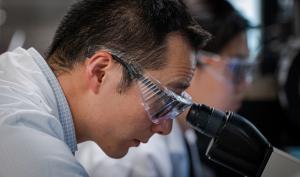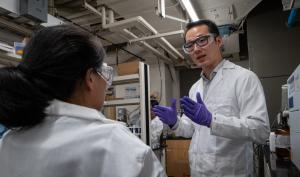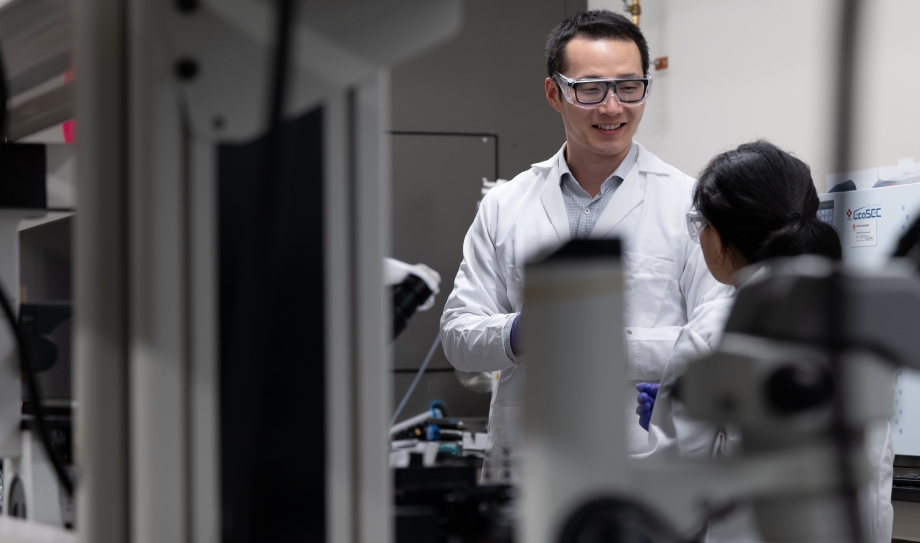CAREER Award: Running Hot and Cold
Liheng Cai Earns Prestigious National Science Foundation Award to Develop Polymeric Material to Control the Types of Energy Streaming into Windows with the Flick of a Switch
Morning sun floods into assistant professor Liheng Cai’s office in the University of Virginia’s Wilsdorf Hall. The photons of infrared radiation carrying heat energy, streaming through his window after their 8-minute, 20-second journey from the sun, are welcome in the winter; they keep Cai warm as he prepares to teach his new class, Advanced Polymers.
But what about those summer days when he’d rather stay cool? Cai is developing adaptive photonic polymers — materials that could be applied to windows and, at the flick of a switch, reflect the invisible infrared wavelengths that toast things up while letting in all other visible light waves, enabling him to keep chill while maintaining his epic view of the UVA School of Engineering.

Cai, who has joint appointments in the UVA Department of Materials Science and Engineering and the Department of Chemical Engineering, and a courtesy appointment to the Department of Biomedical Engineering, recently earned a CAREER AWARD totaling $588,378 from the National Science Foundation to develop photonic polymers for active control of visible and infrared light.
CAREER awards are among the most prestigious for early career faculty, and Cai is a rising star among a strong group of faculty members who are making UVA Engineering a leader in developing soft materials for a wide variety of uses, including smart-building technologies and health care.
“We are creating a type of material that can change the reflective wavelength dynamically and also very quickly,” Cai said. “I’m so excited for this invention. We have a demo and beautiful experimental results so far. And this award would not be possible without the support from the community and mentors, especially the Polymers Program of the NSF Division of Materials Research.”
Cai and his growing lab of post-doctoral researchers and graduate and undergraduate students have already developed a prototype polymeric photonic crystal that’s about half the size of a credit card but can stretch to around 10 times its original size. This is a unique material that is much softer and more stretchable than existing materials, and, if successful, will be the first for active, fast control of light. The next step would be applying these materials to smart windows to regulate energy in and out of buildings; other uses might be camouflage or adaptive optical devices.



“This research has the opportunity to master the science enabling a novel and possibly transformational functional material,” said John Scully, Charles Henderson Chaired Professor and chair of the Department of Materials Science and Engineering. “We are so delighted to have Liheng here to build our soft materials focus.”
Cai points to his background in theoretical physics as a catalyst for this research. “I think the training in theory does benefit my career tremendously. That level of thinking has provided me a way to identify problems of both fundamental and practical importance. And I often come away with a very solid hypothesis, which is either supported by a very strong theoretical foundation or by extensive data from experiments,” Cai said. “And I am in debt to the tremendous support from many senior mentors that allowed me to develop a very diverse background and experience.”
It wasn’t until Cai was working on his Ph.D. in materials science at the University of North Carolina that he began to consider the unique nature of polymers and how they bridge the disciplines of physics — his natural love — and biology, which was an increasing interest for him. Under the supervision of Michael Rubinstein, a renowned professor and theoretical polymer physicist, Cai was exploring the theoretical side of polymers when he was introduced to Dr. Richard Boucher, a world expert in cystic fibrosis, working ON LUNG DISEASES. At that point, Cai began his transition from theoretical science to experimental science. “During that early work, I found that I was much more passionate about experiments and decided to switch to experimental science.”
Cai took this new-found enthusiasm to Harvard University for his post-doctoral research with David Weitz, the Mallinckrodt Professor of Physics and of Applied Physics, and Jeffrey Fredberg, professor of bioengineering and physiology. There, Cai picked up considerable experience in experimental soft matter, such as responsive polymers, biological gels and living systems, like bacteria, cells or tissues, and delved into the art of making polymers. “We made a couple big discoveries while I was there. First, we made a POLYMER THAT WAS SUPER SOFT, like biological tissue or tofu for example, but that contained no water or solvent. A completely soft but dry material that could be used for medical implants or stretch sensors. We also found a way to make A SELF-HEALING RUBBER TIRE, so one day we can hope to not have flat tires anymore.”

“This combination of experimental and theoretical background is what excited us about Liheng from the very beginning,” said William Epling, chair of the Department of Chemical Engineering. “Such a skill set brings a unique perspective to research questions, allowing him to think about and solve big problems. He’s made an immediate impact in research.”
While Cai’s CAREER Award focuses largely on the development of adaptive photonic polymers, his grant proposal also included an educational component that exposes middle school through graduate-level students from diverse backgrounds to research and experimentation in the field of polymer science and engineering. Cai will integrate this research into his new Advanced Polymers course taught to first-year engineering graduate students at UVA Engineering.
“My ambition has always been to be a professor,” he said. “I want to teach students and share my knowledge and skills with them and train them to be the next generation of scientists and leaders in their field. I want to teach them how to do research, how to think about problems, how to identify problems, and how to solve them. This is very rewarding to me.”
Among the many other projects Cai is involved in, he co-launched a weekly seminar series shortly after arriving at UVA in 2018. The series is called SQUISHY MATERIALS and brings together students, researchers and faculty from across UVA to talk about soft materials science and engineering. The program has already led to a pair of collaborative projects. “This has been really fascinating, especially with students. They flock to the seminar because it is informal. They can ask questions anytime during the seminar. There is a lot of really important information coming out of the program.”